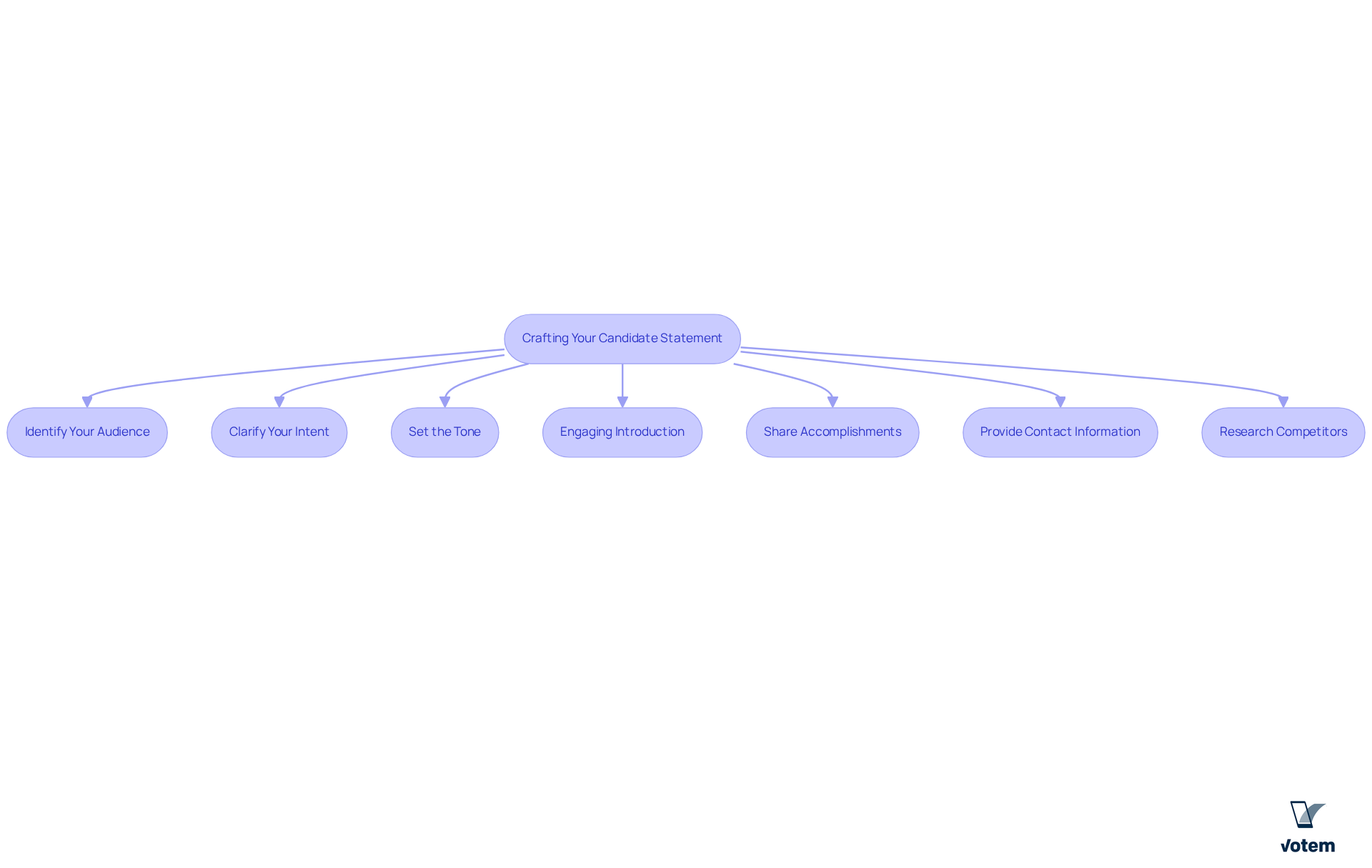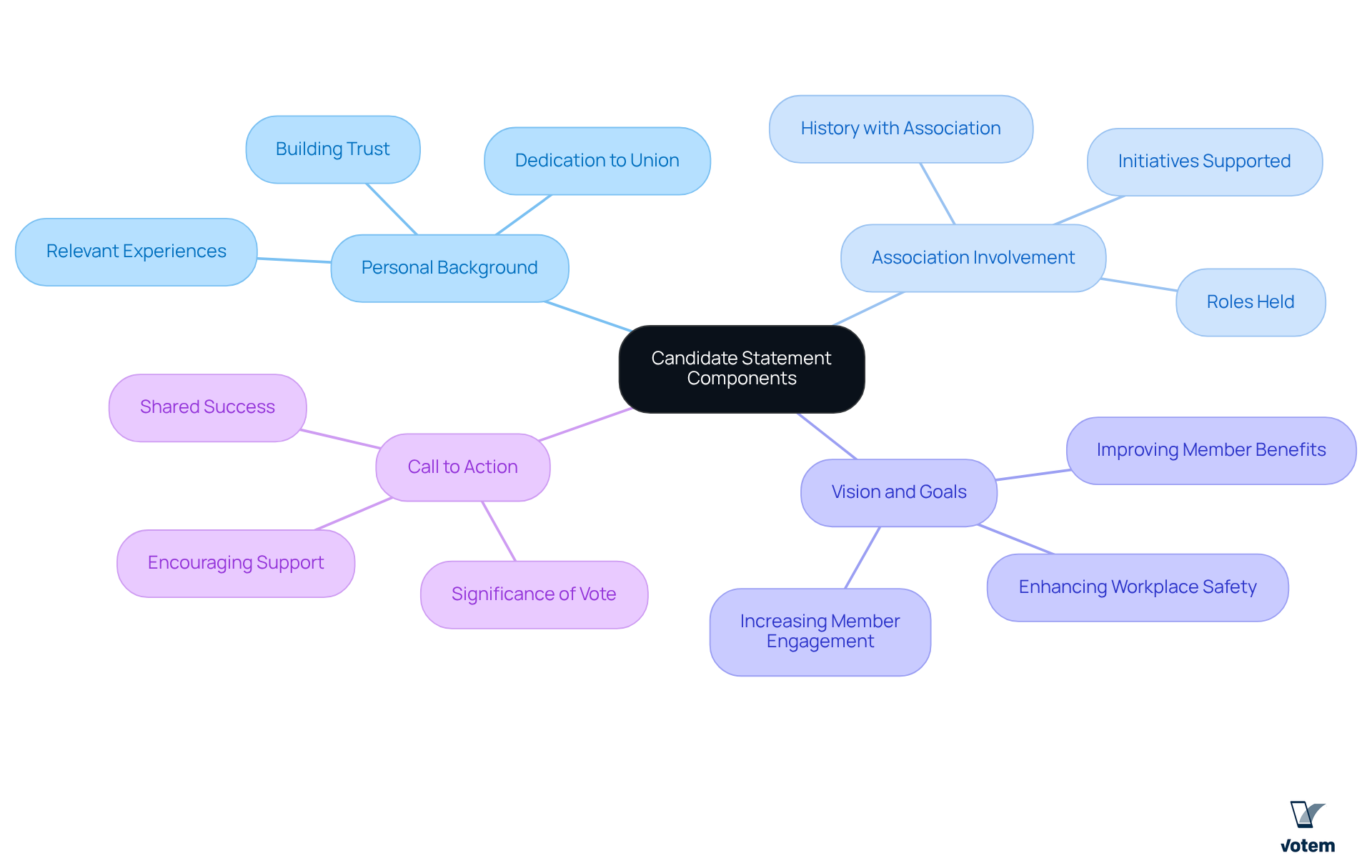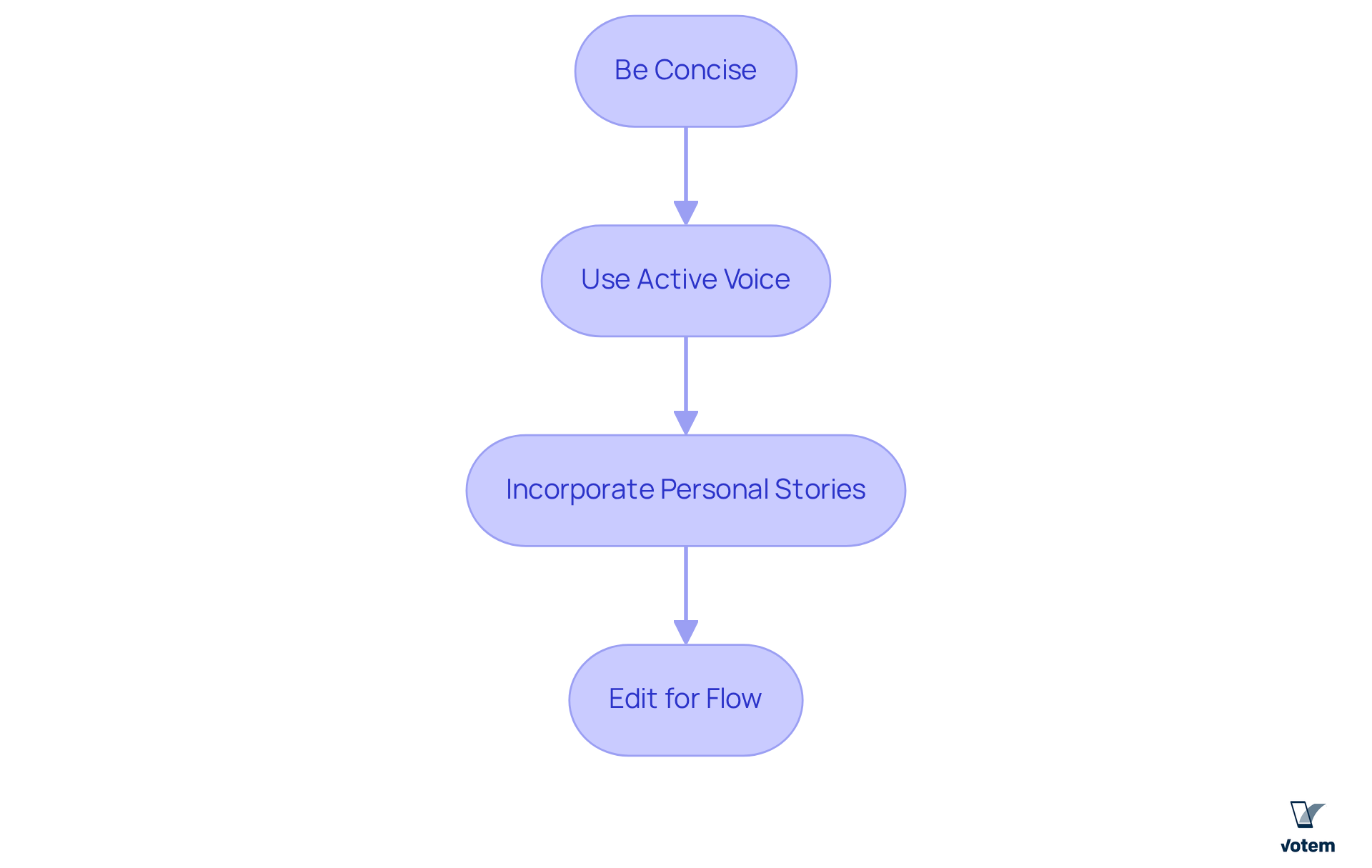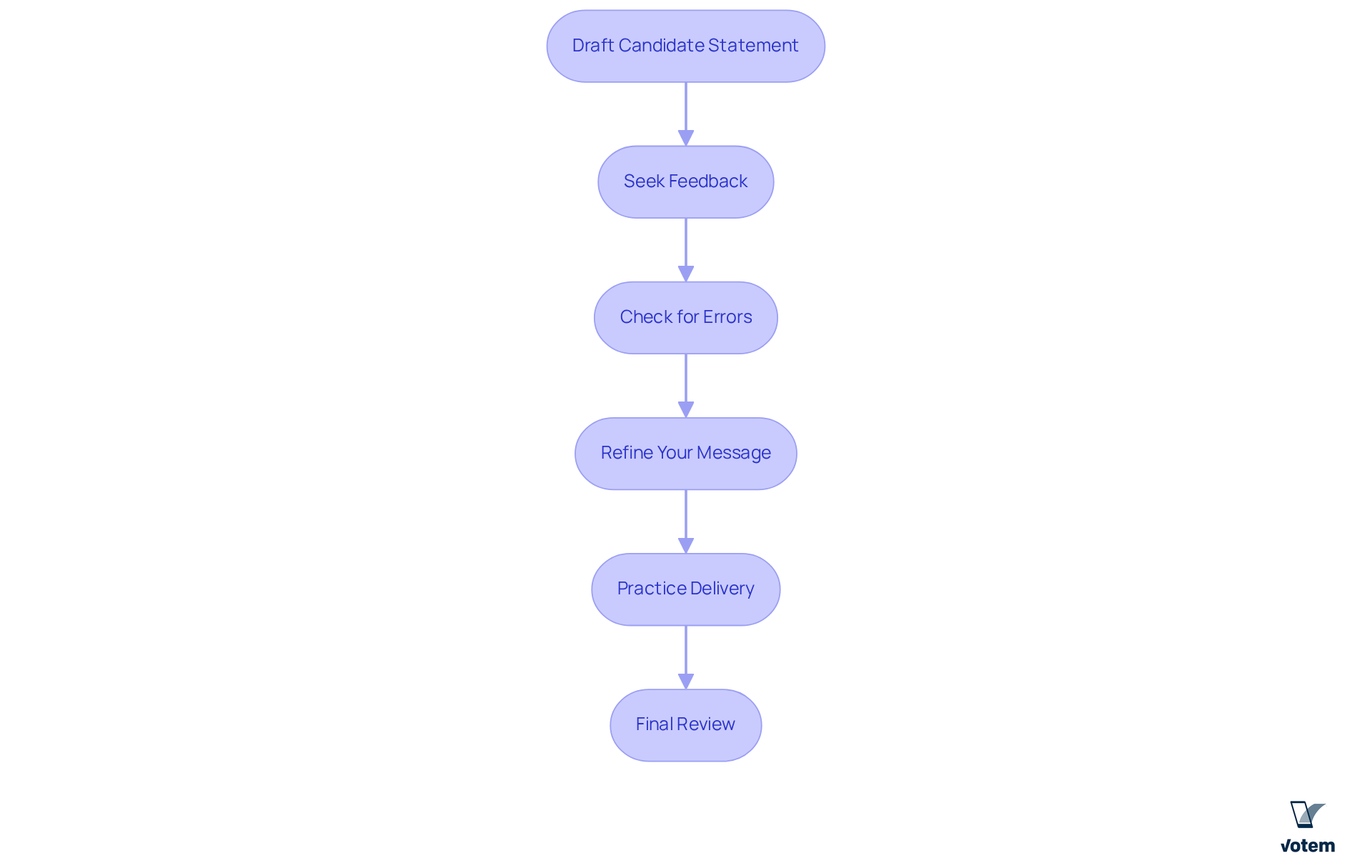Overview
Crafting a winning candidate statement for union elections is essential for success. It requires a clear articulation of your qualifications, vision, and commitment. To resonate with the electorate’s concerns, it is crucial to tailor your message effectively. Personal storytelling plays a vital role in this process, as it engages voters on a deeper level.
Furthermore, a strong call to action and a polished presentation will significantly enhance your chances of success in the election. By focusing on these elements, you can connect with the electorate and inspire their trust and support.
Introduction
Crafting a compelling candidate statement is essential for anyone aiming to make a significant impact in union elections. This crucial document not only introduces candidates to the electorate but also articulates their vision, qualifications, and commitment to the union’s goals.
As candidates navigate the complexities of their statements, they confront the challenge of effectively resonating with voters’ concerns while distinguishing themselves among competitors.
What key elements can transform a standard declaration into a powerful narrative that captivates and motivates union members? By addressing these questions, candidates can elevate their statements from mere introductions to impactful narratives that inspire action.
Understand the Purpose of Your Candidate Statement
A candidate statement serves as a vital introduction to the electorate, outlining your qualifications, vision, and commitment to the union’s objectives. It is essential to clearly articulate your motivations for running for office and the goals you intend to achieve. Consider these key elements:
- Identify Your Audience: Understand who will read your statement and what matters to them. Tailor your message to resonate with their concerns and aspirations, ensuring it addresses the issues they prioritize most.
- Clarify Your Intent: Clearly express your reasons for running. Are you focused on enhancing working conditions, improving communication, or advocating for specific policies? A well-defined intent enables voters to grasp your priorities effectively.
- Set the Tone: Your statement should reflect your personality and leadership style. Whether you adopt a formal or conversational tone, ensure it and values. A sincere and authentic tone can significantly enhance your appeal.
- Engaging Introduction: Include an engaging introduction that highlights your name, current position, and the position you are seeking. This clarity is crucial for the public to quickly understand who you are and what you represent.
- Share Accomplishments: Consider sharing stories or examples of your achievements in the qualifications section. This approach can make your message more relatable and engaging for the audience.
- Provide Contact Information: Including optional contact details or website links can encourage further interaction with constituents, allowing them to connect with you beyond the message.
- Research Competitors and Voter Concerns: Understanding your competitors and the concerns of the electorate can enhance your message, making it more relevant and impactful.
By thoughtfully considering these elements, you can craft a compelling declaration that not only informs but also captivates the electorate, ultimately boosting participation in labor elections.

Identify Key Components to Include
When crafting your , incorporating several key components that resonate with union members and reflect your commitment to their interests is essential.
Personal Background: Begin by sharing relevant personal and professional experiences that showcase your dedication to the union and its members. This connection fosters trust and relatability among voters.
Association Involvement: Highlight your history with the association, detailing any roles you’ve held, initiatives you’ve supported, or contributions you’ve made. Statistics indicate that candidates who effectively convey their participation can significantly enhance member engagement; in fact, 70% of candidates wish to learn about the benefits provided by prospective leaders.
Vision and Goals: Clearly express your vision for the organization and the specific objectives you intend to accomplish if elected. This could include improving member benefits, enhancing workplace safety, or increasing member engagement. A well-defined vision inspires confidence and motivates members to rally behind your candidacy.
Call to Action: Conclude with a strong call to action, encouraging voters to support you. Highlight the significance of their vote in reaching the group’s goals, stressing that their involvement is essential for shared success.
By incorporating these components into your candidate statement, you craft a persuasive story that connects with union members and improves your prospects for election success.

Draft Your Candidate Statement with Clarity and Impact
To draft your candidate statement:
- Be Concise: Strive for clarity by using straightforward language. Avoid jargon and overly complex sentences that may confuse readers. A well-crafted candidate statement can greatly impact elector choices; effective candidate statements usually span from 200 to 1,000 words.
- Use Active Voice: Write in an active voice to instill a sense of urgency and engagement. For instance, instead of saying “I will be working on…”, say “I will work on…”. This approach not only enhances clarity but also makes your intentions more compelling.
- Incorporate Personal Stories in your candidate statement: Share anecdotes that reflect your commitment and passion for the union. Personal narratives can foster a relatable bond with voters, making your message more impactful. Your candidate statement should highlight relevant experiences that demonstrate your qualifications and leadership style.
- Edit for Flow: Ensure that your message transitions smoothly from one point to the next. Logical flow keeps readers engaged and helps them follow your narrative. Consider using bullet points to emphasize key messages, as this format aids in clarity and digestibility.
By concentrating on these elements, you can create a proposal that not only informs but also persuades and engages your audience effectively.

Revise and Polish Your Statement for Maximum Effect
After drafting your candidate statement, follow these essential steps to revise and polish it:
- Seek Feedback: Share your statement with trusted colleagues or union members for constructive feedback. Their insights can significantly .
- Check for Errors: Carefully proofread your text for grammatical errors, typos, and awkward phrasing. A polished expression not only reflects professionalism but also strengthens your credibility.
- Refine Your Message: Ensure your candidate statement is clear and compelling. Eliminate redundant phrases or unnecessary details that may dilute your impact.
- Practice Delivery: If your statement will be read aloud, practice delivering it to ensure it sounds natural and engaging. Adjust any phrasing that feels awkward when spoken, as effective delivery is key to connecting with your audience.

Conclusion
Crafting an effective candidate statement for union elections is not merely a task; it is a crucial step in engaging with the electorate and establishing a strong connection with union members. A well-structured statement introduces a candidate while clearly articulating their vision, qualifications, and commitment to the union’s objectives. This foundational document serves as a platform for candidates to resonate with voters, making it essential to approach its creation with thoughtfulness and clarity.
Key components enhance the impact of a candidate statement, including:
- Understanding the audience
- Sharing personal backgrounds
- Articulating specific goals
A compelling introduction is vital, as is the use of active voice and the inclusion of personal stories to foster relatability. Furthermore, revising and polishing the statement through feedback and careful editing ensures a professional and engaging delivery that can significantly influence election outcomes.
The importance of a well-crafted candidate statement cannot be overstated. It serves as a powerful tool for candidates to connect with union members, inspire confidence, and encourage active participation in the election process. By following the outlined strategies and best practices, candidates can effectively communicate their message and galvanize support. The time to take action is now—craft that winning statement and make your voice heard in the union elections.
Frequently Asked Questions
What is the purpose of a candidate statement?
A candidate statement serves as an introduction to the electorate, outlining your qualifications, vision, and commitment to the union’s objectives. It articulates your motivations for running for office and the goals you intend to achieve.
Who should I consider as my audience when writing my candidate statement?
You should identify who will read your statement and what matters to them. Tailoring your message to resonate with their concerns and aspirations is essential.
How can I clarify my intent in my candidate statement?
Clearly express your reasons for running, such as enhancing working conditions, improving communication, or advocating for specific policies. A well-defined intent helps voters understand your priorities.
What tone should I use in my candidate statement?
Your statement should reflect your personality and leadership style. Choose a tone that aligns with your union’s culture and values, whether formal or conversational, ensuring it feels sincere and authentic.
What should I include in my introduction?
Include an engaging introduction that highlights your name, current position, and the position you are seeking. This clarity helps the public quickly understand who you are and what you represent.
How can I showcase my qualifications in the statement?
Share stories or examples of your achievements in the qualifications section to make your message more relatable and engaging for the audience.
Is it important to provide contact information in my candidate statement?
Yes, including optional contact details or website links can encourage further interaction with constituents, allowing them to connect with you beyond the message.
Why should I research competitors and voter concerns?
Understanding your competitors and the concerns of the electorate can enhance your message, making it more relevant and impactful to voters.
List of Sources
- Understand the Purpose of Your Candidate Statement
- How to Stand Out With a Candidate Statement (https://eballot.com/blog/how-to-write-a-candidate-statement)
- Candidate Statements (https://actuaw.org/candidate-statements.html)
- Leadership Quotes about character, initiative, persistence and risk (https://govleaders.org/quotes.php)
- Identify Key Components to Include
- recruitcrm.io (https://recruitcrm.io/blogs/candidate-experience-statistics)
- smartrecruiters.com (https://smartrecruiters.com/blog/recruitment-statistics-for-2025)
- jobscore.com (https://jobscore.com/articles/candidate-experience-statistics)
- Key Candidate Experience Statistics You Should Know – Applicantz | Free Applicant Tracking System and Recruitment Software (https://applicantz.io/key-candidate-experience-statistics-you-should-know)
- 50 Hiring Statistics to Improve Your Process | Eddy (https://eddy.com/blog/hiring-statistics)
- Draft Your Candidate Statement with Clarity and Impact
- How to Stand Out With a Candidate Statement (https://eballot.com/blog/how-to-write-a-candidate-statement)
- 5 Steps To Write a Winning Candidate Statement—With Examples (https://surveyandballotsystems.com/blog/best-practices/5-steps-to-write-a-winning-candidate-statementwith-examples)
- Candidate Statements — AFSCME Local 328 (https://local328.org/blog/candidate-statements)
- Revise and Polish Your Statement for Maximum Effect
- 165 Resume Statistics: Cover Letters and Valuable Skills (https://flair.hr/en/blog/resume-statistics)
- 26 powerful quotes about feedback (https://netigate.net/articles/surveys/quotes-about-feedback)
- Do law schools actually validate the authenticity of personal statements in some way, or can I embellish to make them sound better? (https://quora.com/Do-law-schools-actually-validate-the-authenticity-of-personal-statements-in-some-way-or-can-I-embellish-to-make-them-sound-better)
- 35 Quotes about Communication to Inspire Collaboration (https://vibe.us/blog/35-quotes-about-communication)

